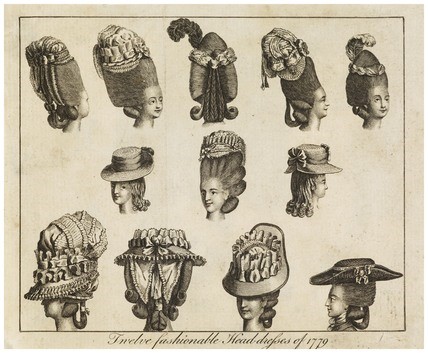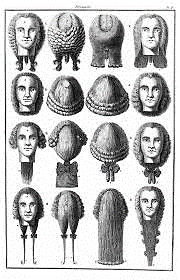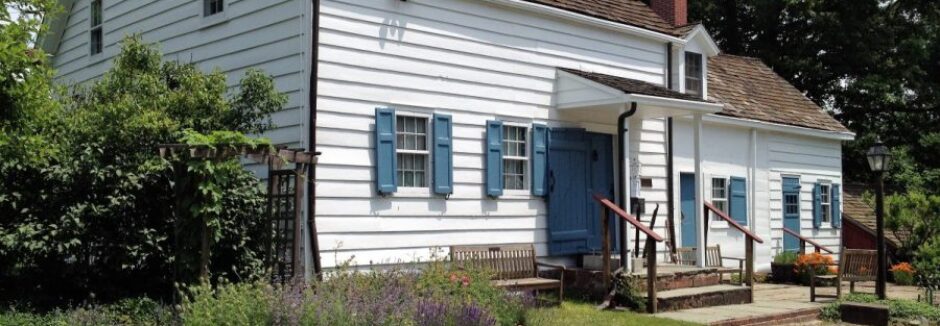Everyone has a bad hair day, but a bad hair month? On one level, maintaining a good hair style these days may seem trivial when so many are facing much more devastating circumstances. However, personal grooming can be an important way of establishing routine, order, and control in an unprecedented time of uncertainty and lack of control.
So what is one to do? Risk mutilation or chemical burns by cutting one’s own hair or mixing one’s own hair dye? Embrace the gray or the straggle, or the shaggy bangs?
Instead, if you are a gentleman of means, why not purchase a Peruke? There are many styles to choose from – perhaps a full bottom periwig, or a bagwig, or a pigeon winged toupee, or a Ramillies plait? A gentlewoman may augment her natural locks with a toque or a cushion or a pad to create a most stylish pouffe – top it off with a small basket of flowers to create a coiffure a la flore! In 18th century Europe and America, wigs and hair pieces were quite the fashion among both men and women of the middle and upper classes, and were often a recognizable sign of rank and occupation.
Numerous ads of the time attest to the popularity of the wigmaker/hairdresser across the colonies. Consider, for example, Henry Davis’s advertisement in the South-Carolina Gazette and Country Journal (April 10, 1770), wherein he listed and described the various kinds of wigs he made “after the most fashionable Manner.” He notes that he carries “all Sorts of Perukes, Tates, Rolls, Mecklenburgh Fronts, Italian Braids, French Curls, English Locks, and Gentlemen’s Side-Locks,” knowing that knowledgeable customers could differentiate among the various styles.
Up north, Timothy Kelly’s ad in the Massachusetts Gazette and Boston Post-Boy (December 25, 1769) announced that he was well informed of the current styles in London, vowing that he made “any kind Perukes now in fashion” and did so “as genteel as can be had from thence.” John Lewis, in the New-York Gazette and Weekly Mercury (August 15, 1768) proclaimed “I am Master of the new Mode, lately invented in London, of making Wigs.” Despite the ongoing disputes with Britain over onerous duties on imported goods, colonists still looked to London for the latest fashions.
And in the Providence Gazette of May 6, 1769, Benjamin Gladding advertised that he made wigs “as cheap as can be had” in Boston or elsewhere. Presenting a fashionable appearance didn’t have to be prohibitively expensive, not even in towns outside cities such as Boston where he would have faced more competition.
And don’t forget the pomade and powder! One’s hair or wig was first covered with a greasy pomade in order to help the powder stick. Powders came in various colors. Men generally used white or gray, while most women chose off-white, although the powders could also be found in pastel colors such as violet or pink. The aforementioned Mr. Davis states that he carries, in addition to the wigs, “fine Pomatum and scented Hair-Powder.” Messrs. William & Stanwood, in the New-Hampshire Gazette (February 6, 1768) made it easy for women to appear smartly coiffed by selling women’s “rough toupees” “with or without Powder.” Such wigs “preserve their Form, and want no dressing.” Women did not need excessive leisure time to prepare themselves to receive guests or appear in public since these wigs were “so easily fixed that Ladies may Dress themselves in five Minutes Time, fit for any Company.”
Do any of these appeal to you?


Above– The Ladies’ Own Memorandum Book (1779)
Below – L’art du perruquier by Francois Alexandre de Garsault (1767)
f you’re still determined to be your own hair colorist, we offer two recipes from The toilet of Flora by Pierre-Joseph Buc’hoz (1779):
To change the Color of the Hair.
First wash your head with springwater, then dip your comb in Oil of Tartar, and comb yourself in the Sun: repeat this operation three times a day, and at the end of eight days at most the hair will turn black. If you are desirous of giving the hair a fine scent, moisten it with Oil of Benjamin.
A Fluid to die the Hair of a flaxen Colour.
Take a quart of Lye prepared from the Ashes of the Vine Twigs; Briony, Celandine Roots, and Turmeric, of each half an ounce; Saffron and Lily Roots, of each two drachms; Flowers of Mullein, Yellow Stechas, Broom, and St. John’s-wort, of each a drachm; boil these ingredients together, and strain off the Liquor clear. Frequently wash the hair with this fluid, and in a little time it will change to a beautiful flaxen colour.
Glossary:
Bagwig: The wig was gathered back and tied into a queue, which was enclosed in a black silk bag with a gathering string. The string was concealed by a stiff black bow at the nape of the neck.
Pigeon winged toupee: Wig made with loosely curled locks of hair over the ears.
Periwig: Used interchangeably with peruke; generally long with curls on the side. A full bottom periwig had a mass of curls framing the face and flaring below the shoulders.
Peruke: A man’s wig of the 17th/18th century
Pouffe: An elaborate hair style which utilized everything from wire, cloth, gauze, wigs, animal hair, and the wearer’s own hair to create a voluminous coiffure that could be used as a canvas to express feelings (pouf à la sentiment) or commemorate events (pouf à la circonstance)
Ramillies plait: Wig that was bushy at the sides, with a long braided queue tied at the top with a large bow and the bottom with a smaller bow.
Toques/cushions/pads: Various shaped supports intertwined with a woman’s natural hair and hair pieces used to provide structure for elaborate hair styles
